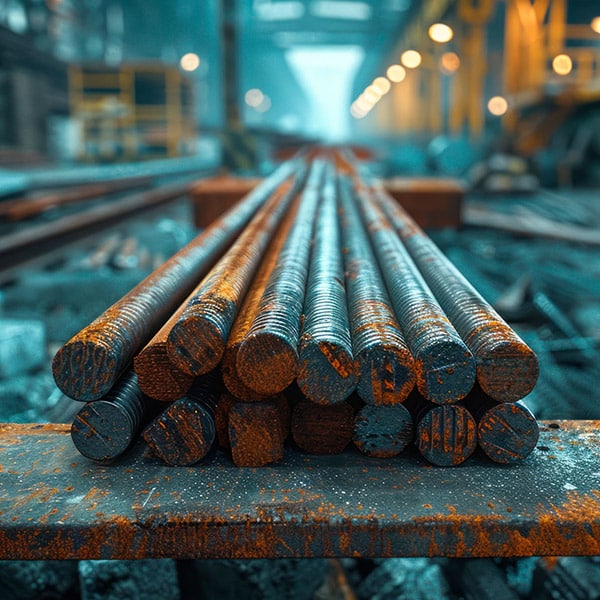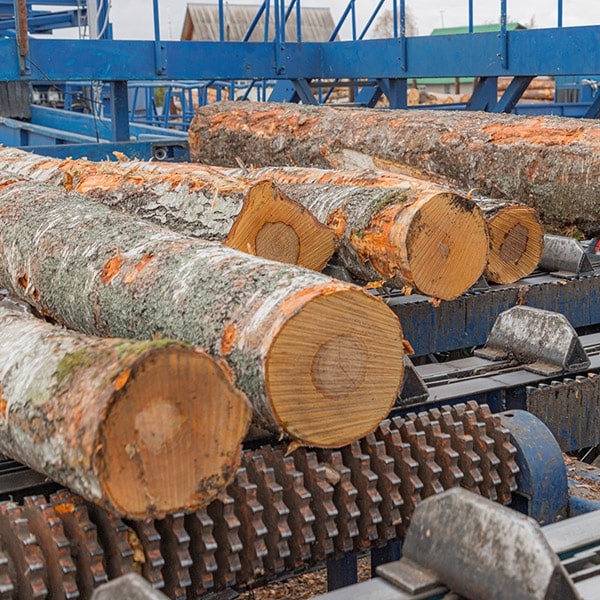
Tariffs levied in 2018 fueled higher construction prices
The return of restrictive tariffs as a tool to lower the U.S. trade deficit has once again raised alarms about their impact on the construction sector. In 2018, the last time the Trump administration broadly imposed tariffs, the consequences were swift and measurable. U.S. spending on construction-related imports — across roughly 700 items — remained elevated for nearly two years compared with pre-2016 levels (Figure 1), even before tariffs were assessed at ports of entry. That outcome defied long-standing trade theory, which holds that tariffs should lower the volume of imports and reduce the price paid to foreign suppliers.
Sources: U.S. International Trade Commission, Global Supply Chain Pressure Index, Federal Reserve Economic Data, New York Fed, Bergstrom Real Estate Center
We examined two of the most essential construction inputs — rebar and lumber — and found they offer a window into how real-world outcomes diverged from textbook predictions. Prices for both materials climbed during 2018–2020, exceeding pre-tariff levels even before accounting for duties. Domestic suppliers also raised their prices. By conservative estimates, we calculated that tariffs and foreign pricing pressures pushed up unit costs by 10% to 13%.
What builders experienced during that period ran counter to the intended effects of protectionist policy: higher costs, not just on imported goods, but on domestically produced materials as well. And those increases were ultimately passed along to consumers. The 2018 tariffs illustrate how trade policy — even when aimed at stimulating domestic production — can instead inject volatility and inflationary pressure into critical supply chains like construction. One critical truth remained buried beneath the headlines: improvements in domestic manufacturing were temporary at best.
We focused our analysis on the period before the onset of the COVID-19 pandemic. The years that followed were shaped by volatile housing demand, rising interest rates, supply chain disruptions and new trade policies — complicating direct comparisons.
Before the tariffs were implemented in 2018, a significant proportion — from 55 to 25% — of key construction materials used in the United States were imported, including metal, machinery and wood products. The United States later removed exemptions for the European Union, Canada and Mexico, and applied three rounds of tariffs on Chinese goods. Canada, a major supplier of iron, steel and wood products, was directly affected. Brazil, another major exporter, agreed to restrict its shipments under pressure.
Figure 2 illustrates the share of import spending, incorporating tariffs, relative to total spending on primary metals and lumber in the construction industry in 2017 and 2019 — the years before and after the 2018 tariffs. In 2019, the spending share of imported products declined marginally: roughly 1 percentage point for metals and 1.5 percentage points for wood. These shifts may reflect new sourcing strategies and increased share of spending on domestic products, likely tied to enhanced production capabilities.
Source: U.S. Bureau of Economic Analysis

Domestic market
In Figure 3, we shift our focus to the domestic market to examine domestic price trends for steel and lumber as measured by the producer price index (PPI). The PPI for domestically produced steel and wood saw a notable 10% increase at the beginning of 2018 compared with 2017. These prices remained elevated until mid-2019 for steel, which coincided with the reduction in tariffs for steel imports from Canada, Mexico and Turkey.
Sources: U.S. International Trade Commission, Global Supply Chain Pressure Index, Federal Reserve Economic Data, New York Fed, Bergstrom Real Estate Center
Interestingly, manufacturing outputs began to rise in mid-2017, well before the tariffs took effect, likely driven by anticipation from buyers. However, output started to decline shortly after mid-2018, particularly following the termination of exemptions on trade with Canada and Mexico. Despite heavy tariffs imposed on Chinese products, the decline in manufacturing output persisted, hinting at potential barriers created for critical manufacturing inputs by imposing tariffs and slashed export demand for U.S. manufacturing goods from its trading partners.


Although sectoral output showed signs of improvement towards the end of 2020, it has yet to fully recover to pre-tariff levels. Meanwhile housing starts and related spending far exceed pre-COVID levels. The increase in the domestic share of spending in 2019 (shown in Figure 2) likely stemmed from temporary price hikes rather than a boost in domestic manufacturing. This raises the important question of whether builders ultimately benefited from the foreign price reductions that tariffs were intended to bring. Further analysis is needed to explore this aspect comprehensively.
With the imposition of new tariffs, rebar (Figure 4A) and wood (Figure 4B) initially pointed towards rising prices and quantities. Rebar prices kept increasing for a while after trade restrictions were put in place before turning around. Imports showed steady demand between 2018-2020. Rebar imports spiked well before tariffs hit, likely due to buyers trying to avoid higher costs. This stockpiling of materials to avoid price hikes is a common tactic during tariff scares. In March, the Wall Street Journal reported the tariffs imposed by the new Trump administration this year has prompted builders to stockpile lumber and swap out materials, such as replacing Canadian-grown Douglas fir wood for cheaper Southern pine, which can be sourced domestically. Overall, tariff-excluding rebar expenditure remained approximately stable between 2018-2020, a trend that started in 2015. This implied that the extra costs came from the tariff burden that were imposed on foreign steel purchases.
Sources: U.S. International Trade Commission, Global Supply Chain Pressure Index, Federal Reserve Economic Data, New York Fed, Bergstrom Real Estate Center
Sources: U.S. International Trade Commission, Global Supply Chain Pressure Index, Federal Reserve Economic Data, New York Fed, Bergstrom Real Estate Center
The quantity and price of imports of about 100 types of plywood, wood panels and blockboard are shown in Figure 4B. These two variables responded similarly to the tariffs — at least temporarily. The quantity of wood imports increased roughly 10% between the spring of 2018 and early 2019, before falling even more. Similarly, the price of wood imports spiked about the same time as tariffs went into effect. Even if one excludes the tariffs and shipping, overall spending on these products increased. Then, tariffs added another layer of cost for builders.

So, for both rebar and wood products, it is evident that builders had to pay more not only to foreign sellers but also to domestic producers, which had gained temporary pricing power. This resulted in increased costs that were ultimately passed on to consumers in the form of higher prices for homes and other construction projects.
Deeper data dive
When we delve deeper into the numbers, the impact of the tariffs becomes even more pronounced. If we hypothetically assume foreign price for rebar was not affected by trade barriers and that builders still had to pay the 25% duty to the U.S. customs, this would result in the average cost to import a unit of rebar — measured in kilograms — increasing from roughly 55 cents to 70 cents during 2018-2019. When considering that steel articles account for approximately 25% of overall primary metal imports, the cost increases by approximately 6.25% (the calculation is: 25% of 25% = 6.25%). Simultaneously, a 10% increase in the price of domestically produced steel (with a 75% market share) translates to a 7.5% hike in the cost per unit. When combined, this indicates that the expenditure on a unit of steel article surged by 13.75%.
For lumber, there was a noticeable price hike from $650 a unit (measured by cubic meter) to around $720 a unit, and the addition of a 10% tariff would further push it to $727 a unit, reflecting an approximate 12% increase in post-tariff prices. Assuming a 10% share of lumber imports in construction and a 90% domestic utilization rate, the 10% temporary domestic price increase and the 12% import price hike together would result in a 10.2% increase in lumber cost per unit. These figures underscore the significant cost implications faced by builders and consumers alike in the wake of tariff measures.
Studies on international trade examining the repercussions of the 2018 tariffs support these observations. For instance, while we found no specific research on construction materials, a study found that, prices of washing machines and dryers increased by 12%, following tariffs (NBER working paper No. 25767). Academic researchers from diverse backgrounds said these higher prices were a complete pass-through of tariff burden from foreign producers to U.S. consumers.
Wrapping up
Analyzing specific import data for key materials like rebar and wood highlights the significant cost implications resulting from tariff measures, ultimately burdening both builders and consumers. Academic studies support these findings, indicating that tariff-induced price increases lead to increased costs for consumers with limited control.
The U.S. has used tariffs to address trade imbalances and intellectual property concerns, sparking retaliation from China. As we finalized this story in June, diplomatic efforts were showing the potential for cooperation, as the U.S. and other countries had lower or removed some tariffs. But the 25% tariffs on steel and aluminum imposed earlier in 2025 were still in effect and experts feared that new tariffs may be levied, increasing consumers concern that tariffs will cost them sooner than later.
Tariffs in 2018 raised the price for developers, and domestic manufacturing outputs increased temporarily, possibly because importers diversified sources. This perhaps has led to this current trade-war where imports from all countries are now subject to tariffs. It is worth noting that the tariff effects were dwarfed by the turbulent period of supply side disruptions.

Nevertheless, it’s clear that the enforcement of tariffs carries profound implications. First, a widespread tariff on all countries may harm U.S. exports, which accounts for about 11% of U.S. gross domestic product. Second, for construction, trade disruptions would be an added stress at a time when the country’s working population is increasingly aging and unemployment in the construction industry is high. In fact, the National Association of Home Builders’ Housing Market Index in recent months has shown increasing pessimism towards the housing market. The index, which gauges builder perceptions of current single-family home sales and sales expectations, fell in May to the third-lowest reading since 2012. “Buyers are increasingly moving to the sidelines due to elevated mortgage rates and tariff and economic uncertainty,” said Buddy Hughes, NAHB chairman. “To help address affordability concerns and bring hesitant buyers off the fence, a growing number of builders are moving to cut prices.”
Enduring cooperation with other countries can be maintained if the U.S. reasonably values its future as its present. A strategic approach that prioritizes collaboration and negotiation over unilateral actions can pave the way for enhanced stability and growth within the construction industry and the broader economic landscape.
Arijit Ray, Ph.D., is a real estate researcher at the UF Bergstrom Real Estate Center.
Related stories
For the media
Looking for an expert or have an inquiry?
Submit your news
Contact us
Follow us on social
@ufwarrington | #BusinessGators


